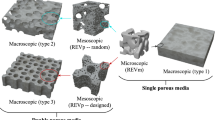Abstract
Based on the coupled problem of time-dependent fluid–structure interaction, equations for an appropriate adjoint problem are derived by the consequent use of the formal Lagrange calculus. Solutions of both primal and adjoint equations are computed in a partitioned fashion and enable the formulation of a surface sensitivity. This sensitivity is used in the context of a steepest descent algorithm for the computation of the required gradient of an appropriate cost functional. The efficiency of the developed optimization approach is demonstrated by minimization of the pressure drop in a simple two-dimensional channel flow and in a three-dimensional ducted flow surrounded by a thin-walled structure.





















Similar content being viewed by others
References
Farhat C, van der Zee K, Geuzaine P (2006) Provably second-order time-accurate loosely-coupled solution algorithms for transient nonlinear computational aeroelasticity. Comput Methods Appl Mech Eng 195:1973–2001
Willcox K, Paduano J, Peraire J (1999) Low order aerodynamic models for aeroelastic control of turbomachines. In: Proceedings of 40thAIAA/ASME/ASCE/AHS/ASC structures, structural dynamics and materials(SDM) Conference St. Louis, USA, pp 1–11
Tezduyar T, Aliabadi S, Behr M, Johnson A, Kalro V, Litke M (1996) Flow simulation and high performance computing. Comput Mech 18:397–412
Johnson AA, Tezduyar TE (1999) Advanced mesh generation and update methods for 3D flow simulations. Comput Mech 23:130–143
Jameson A (1995) Optimum aerodynamic design using CFD and control theory. AIAA-95-1729-CP
Jameson A (1988) Aerodynamic design via control theory. J Sci Comput 3(3):233–260
Jameson A, Shankaran S, Martinelli L (2003) An unstructured adjoint method for transonic flows. AIAA paper, 16th AIAA CFD Conference Orlando
Jameson A (2003) Aerodynamic shape optimization using the adjoint method, 11–14. Department of Aeronautics and Astronautics Stanford University, Von Karman Institute Brussels
Othmer C (2008) A continuous adjoint formulation for the computation of topological and surface sensitivities of ducted flows. Int J Numer Methods Fluids 58:861–877
Soto O, Löhner R (2004) On the computation of flow sensitivities from boundary integrals. In: 42nd AIAA aerospace sciences meeting and exhibit, Reno, NV
Quarteroni A, Rozza G (2003) Optimal control and shape optimization of aorto-coronaric bypass anastomoses. Math Models Methods Appl Sci 13(12):1801–1823
Lincke A, Rung T (2012) Adjoint-based Sensitivity Analysis for buoyancy-driven incompressible Navier–Stokes equations with heat transfer. In: Proceedings of 8th international conference on engineering computational technology
Bazilevs Y, Hsu M-C, Bement MT (2013) Adjoint-based control of fluid–structure interaction for computational steering applications. Proc Comput Sci 18:1989–1998
Bazilevs Y, Takizawa K, Tezduyar TE (2013) Computational fluid-structure interaction (methods and applications). Wiley, Hoboken
Bazilevs Y, Calo VM, Hughes TJR, Zhang Y (2008) Isogeometric fluid-structure interaction: theory, algorithms, and computations. Comput Mech 43:3–37
Tröltzsch F (2010) Optimal control of partial differential equations: theory, methods and applications. AMS, Providence
Hinze M et al (2009) Optimization with PDE Constraints. Springer, Berlin
Degroote J, Bathe KJ, Vierendeels J (2009) Performance of a new partitioned procedure versus a monolithic procedure in fluid–structure interaction. Comput Struct 87:793–801
www.openfoam.com. OpenFOAM is a registered trade mark of Silicon Graphics International Corp
Issa RI (1986) Solution of the implicitly discretized fluid flow equations by operator-splitting. J Comput Phys 62(1):40–65
Düster A, Hartmann S, Rank E (2003) p-FEM applied to finite isotropic hyperelastic bodies. Comput Methods Appl Mech Eng 192:5147–5166
Netz T, Düster A, Hartmann S (2013) High-Order finite elements compared to low-order mixed element formulations. ZAMM-Z Ang Math Mech 93:163–176
Radtke L, Larena-Avellaneda A, Debus ES, Düster A (2016) Convergence acceleration for partitioned simulations of the fluid-structure interaction in arteries. Comput Mech 57:901–920
König M, Radtke L, Düster A (2016) A flexible C++ framework for the partitioned solution of strongly coupled multifield problems. Comput Math Appl 72:1764–1789
Brändli S, Düster A (2012) A flexible multi-physics coupling interface for partitioned solution approaches. Proc Appl Math Mech 12:363–364
Lincke A, Rung T, Hinze M (2014) An efficient line search technique and its application to adjoint topology optimization. In: 85th annual meeting international association of applied mathematics and mechanics (GAMM)
Galvez M, Badilla L, Valencia A, Zarate A (2005) Non-Newtonian blood flow dynamics in a right internal carotid artery with a saccular aneurysm. Int J Numer Methods 50:751–764
Radtke L (2013) Ein partitionierter Ansatz zur Simulation der Fluid-Struktur-Interaktion an der Schnittstelle zu künstlichen Blutgefäßen und endoluminalen Gefäßstützen, Master thesis TU Hamburg-Harburg
Author information
Authors and Affiliations
Corresponding author
Rights and permissions
About this article
Cite this article
Heners, J.P., Radtke, L., Hinze, M. et al. Adjoint shape optimization for fluid–structure interaction of ducted flows. Comput Mech 61, 259–276 (2018). https://doi.org/10.1007/s00466-017-1465-5
Received:
Accepted:
Published:
Issue Date:
DOI: https://doi.org/10.1007/s00466-017-1465-5




